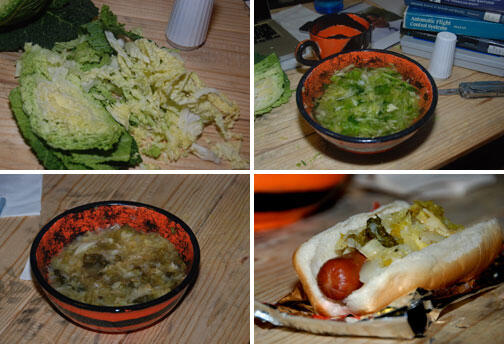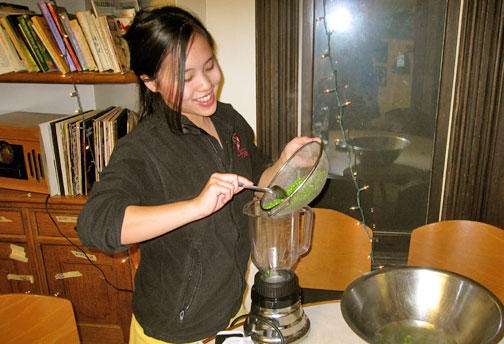The ‘4-hour’ test kitchen
Student bloggers try recipes from Tim Ferriss ’00’s new cookbook
The recipe: Sauerkraut
The challenge: Ferment your own cabbage without alienating your roommate.
In the right quantity, sauerkraut can add a soft, tangy finish to even the most flavorless hot dogs. I’ve eaten the stuff about once a month for years, but until last month, I always assumed sauerkraut magically appeared in large tin bowls with those characteristic hinged metal lids.
When I discovered Timothy Ferriss ’00’s home-brew sauerkraut fermentation recipe in The 4-Hour Chef and resolved to try the recipe for myself, it seemed like an interesting challenge for me, a student with no cooking ability or equipment (unless you count a mini fridge). But I procured a cabbage from the local Shop-Rite, borrowed a salt shaker from the Cap and Gown Club dining room, dug out a bowl and coffee mug from under my bed, and with the help of the pocket knife my mom bought for me for Outdoor Action, I got to work turning cabbage into sauerkraut.
The recipe was easy to follow: cut thin strips of cabbage, add salt and mash the mixture until the cabbage releases its liquid. Do all this to the tune of “Sour Girl” by the Stone Temple Pilots, and then watch the cabbage strips slowly morph into sauerkraut over the next week. Easy, right?
But absent from the recipe were suggestions for how to handle the pungent odor that would accompany the brining cabbage. I wouldn’t call the concoction acrid, but the smell did have a sweet, acidic quality that asserted itself over great distance. My roommate claims he could smell it from the entry to our building, one floor below our room.
After about a week, I took a walk to Butler College’s Studio 34 to buy a hot dog with which to try the home-brew sauerkraut, and I’m surprised to say that it wasn’t bad. I honestly wouldn’t recommend trying the recipe yourself, unless you are either anosmic or have a very large house where you can avoid the smell for a week, but I’m certainly glad I tried it once.
The recipe: Salmon sink sous-vide
The challenge: Cook tender salmon filets in your bathroom (or kitchen) sink.
Cooking dinner in a Ziploc bag in a sink sounds like a dorm food fallback only a step above instant noodles. But Ferriss claims that DIY sous-vide cooking is chic enough for the bathrooms of five-star hotels.
I would say the meal a friend and I created fell somewhere between the high and the low — tender salmon filets garnished with mango salsa sat atop a bed of Uncle Ben’s 90-Second Ready Rice, seasoned with salt and pepper packets swiped from the Nassau St. Seafood and Produce Co., served with an $8 bottle of pinot noir, and eaten with mini plastic forks in the greasy communal kitchen of Pyne Hall.
The process itself was simple, if slightly absurd: I squeezed my fish in their one-gallon Ziploc bags and turned on the InSinkErator to dispense near-boiling water. I stuck my new thermometer into the water, only to remember that humans, and thus their medical thermometers, never reach the ideal sous-vide temperature of 52° C (126° F). When I lowered the bags into the water, they shrunk snugly, as advertised, around the filets, which immediately lost their translucence and soon began oozing white proteins.
Twenty minutes later, they were done. Despite the uncertainty of our water temperature and occasional leaking of the bags, the salmon still turned out tender, flaky, and satisfying.
For those tired of carcinogenic grilling or stranded in an oven-less place, sink sous-vide is a neat, delicious alternative to prepare protein. And for those tired of packaged ramen or hotel restaurants, Ferriss has provided a somewhat classy solution.
The recipe: Helicopter-blade pea soup
The challenge: Turn two ingredients into restaurant-quality soup.
Simplicity is a tantalizing but often unattainable dream for your average overworked Princeton student. So when I received an assignment to make pea soup out of just two ingredients — peas and salt — I got a little suspicious. The recipe sounded too basic to be right, and even more so after the following conversation with fellow cooks in the 2 Dickinson Street vegetarian co-op.
“What are you making?” they asked.
“Pea soup,” I said. “The recipe calls for only two ingredients: peas and salt.”
“…Ew,” said one.
Things didn’t sound too promising, but I powered on. The recipe essentially asks that you boil water, boil peas in the water, drain the peas in a sieve, and blend them to smithereens. You then strain the bright green, baby-food-like substance that remains into a saucepan and reheat it over low heat. The secret to tricking dinner guests into thinking that you’ve put more effort into the soup than simply peas and salt is blending the mixture for far longer than you normally would. While lay folks typically blend simply by “blitzing the food for 30 seconds on high,” Ferriss writes that the secret is actually going “ape-[bleep] at 10,000 rpm for 10 minutes.” This is the crucial secret that prompts them to believe that cream or chicken stock were in your list of ingredients, he says.
The soup ended up almost lime-green and extremely smooth. It tasted decent enough, with a very intense pea flavor. But having never tried pea soup, I didn’t trust my own review — so I passed the task on to friends in the vegetarian co-op.
“It takes like you … mashed up a lot of peas,” a friend said.
“It looks like Shrek,” said one.
“It tastes like baby food,” said another. “I like it!”

The recipe: Eggocado
The challenge: Make a tasty, no clean-up breakfast.
As far as I’m concerned, there’s no such thing as too much avocado. It’s the incredible edible egg of the fruit world — rich, creamy, yet still basically nutritious.
So naturally I jumped at the chance to make the “eggocado,” an avocado with an egg baked into its center. When I told some friends about this, they were skeptical, even disgusted, by the idea. They said that egg and avocado together would be too much of a good thing — to which I replied that they simply do not love avocados like I do.
I hesitate to call what I did — pour an egg into a hole — “cooking,” but let the record show that this dish can be prepared by a college student for whom a home-cooked meal consists of microwaved pita and hummus. The eggocado was a baby step toward cooking. Maybe more of a side-step.
I am sorry to admit that it was a little too much of a good thing. I threw in some salt and cumin before baking, but without the Sriracha I added to taste, the eggocado wouldn’t have had much flavor at all. As a stand-alone dish, it fell flat. It lacked texture and acidity to cut the double dose of mildness.
But as a combination of two of my favorite ingredients, the eggocado satisfied. It begged the question: What else can I put in an avocado? Why don’t I just use avocados as edible bowls for everything else I eat?















No responses yet